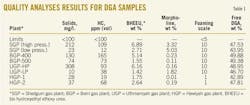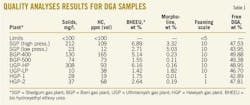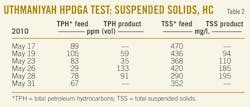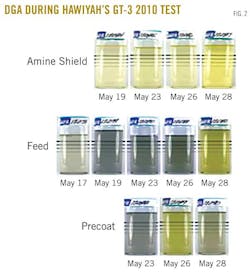P. 3 ~ Continued - Amine cleaning technology tests successfully in Aramco plants
Displaying 3/6
View Article as Single page
The skid-mounted unit takes a slipstream from the DGA system and passes it through the SSX media, which trap suspended solids. Then the stream continues to the HCX unit to remove hydrocarbons, after which the clean stream is returned to the main amine system.
When the unit is exhausted, it is switched to the regeneration mode, which introduces hot water to remove the solids and hydrocarbon waste from the SSX and HCX. The unit is operated until the amine system's inventory is cleaned to a target value (typically less than 100 mg/l. suspended solids and 100 ppm vol hydrocarbon).
Methodology
DGA samples from units with operational concerns were sent to MPR Inc. for suspended solids, hydrocarbons, and other common DGA contaminant analyses. Because of the numerous DGA units within Saudi Aramco, the number of samples was limited. Table 1 shows the results.
Typically recommended suspended-solids and hydrocarbon content for gas-treating units are, respectively, 100 mg/l. and 100 ppm (vol). Based on the analyses, the mobile unit was installed at Uthmaniyah plant's high-pressure DGA. Later, Hawiyah plant management highlighted a concern in the DGA solution quality at GT-3 and showed its interest to have a field trial at HGP GT-3. They shared the expenses of the technology test.
Therefore, this was an opportunity to confirm technology benefits at another facility and resolve a current operational issue.
The Amine Shield slipstream unit was tested at the two locations. Samples of DGA upstream of the Amine Shield (system-feed), downstream of the unit, and downstream of the existing precoat filters were collected throughout the test and sent for analyses. Additional samples were also sent to gas plant labs and research and development to monitor the unit's performance and compare it with MPR results.
The gas plants' lab results showed discrepancies and scatter, which made them difficult to utilize. These results have shown, however, a large reduction in suspended solids content across the Amine Shield unit.
Uthmaniyah HPDGA unit
Testing of the Amine Shield slipstream unit started at the Uthmaniyah high-pressure DGA system on May 17, 2010, and was completed on May 31, 2010. During cleaning, a slipstream of DGA from upstream of the precoat filter downstream of the precoat filter pumps has been passing through the Amine Shield unit.
The cleaned DGA was returned to the flash drum through the outlet piping from the DGA sump downstream of the sump filters. During regeneration, the unit used hot water from the 330-psig steam condensate to the precoat filter line. The waste stream was sent to the wet blowdown system through a piping connection from the unit to the 2-in. blowdown line from the DGA stripper reflux drum.
Samples collected during the test period were sent to MPR laboratory in the US for suspended solids, hydrocarbon, and composition analyses. Table 2 shows the suspended solids and hydrocarbon analyses results.
The performance of MPR's Amine Shield slipstream unit has been good. There was significant improvement in amine quality across the Amine Shield unit when compared with the exist-ing precoat filter. Fig. 2 shows the sustained technology performance throughout the test compared with precoat filter.



